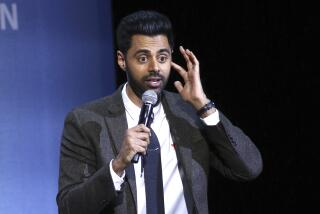A Treasure on Islam for Working Scholars
- Share via
Amir Hussain will never forget his first meeting with Wilfred Cantwell Smith, probably the greatest scholar of Islam and comparative religion that Canada has ever produced.
It was a decade ago, recalls Hussain, who now heads the Islamic Studies Program at Cal State Northridge. At the time, however, the 34-year-old assistant professor was a nervous graduate student about to make his first important academic presentation before the Canadian Society for the Study of Religion.
In preparing his paper, Hussain had referred to Smith’s major work, “The Meaning and End of Religion.” And then the Great Man himself walked into the room where Hussain was to speak.
“I was mortified,” Hussain recalls. “What was he going to say about my use of his ideas? I had no idea.”
But the talk went well, so well that Smith approached the uneasy graduate student to congratulate him.
“He actually came up to me afterwards and asked if he could shake my hand, which absolutely blew me away,” says Hussain. “That’s the first time I thought I might be able to make it in this profession.”
Hussain told that story recently at the official opening of the Wilfred and Muriel Smith Collection, which Smith and his wife donated to CSUN in 1998. Smith died in February at the age of 83.
Superficially, the collection is a group of about 500 books and periodicals on Islam in English, Persian, Arabic and Urdu. It is not a collection of rare books or manuscripts, but rather a working scholar’s collection--the books that he or she might keep on hand in order to chase a promising idea through the existing literature.
It was indeed the personal library of professor Smith, who founded the pioneering Institute for Islamic Studies at McGill University in Montreal and helped found the prestigious Department and Center for the Study of World Religions at Harvard.
In a single stroke, the collection doubled CSUN’s holdings in Islamic studies. All but a few rare items will circulate through the university library (those few will be accessible through special collections) and thus should be of great value to students and scholars of Islam.
*
As Hussain, who was born in Pakistan and grew up in Canada, explains, Smith revolutionized Islamic studies and indeed the modern study of religion.
The standard way to study Islam pre-Smith was to do a close analysis of texts written by Muslims. Smith, a Presbyterian minister, decided to actually live among Muslims in India, to ask them what they thought and observe what they did and then to write about it.
His approach was a radical one. He argued, Hussain recounts, that “religion is best understood as the living, vital faith of individual persons rather than an abstract set of ideas and doctrines.”
As Smith’s clout grew, he also brought more and more Muslim scholars into a field that had been dominated by non-Muslims. Smith also broadened the scope of Islamic studies to include South and Southeast Asian Islam, as well as the classical Islam reflected in ancient Arabic, Persian and Turkish texts.
As a result of Smith’s kindness to an insecure graduate student, Hussain became friends with the scholar and his wife. After Smith suffered a series of small strokes, the couple decided to give up their big house in Toronto and move into a one-bedroom apartment. A major concern was what to do with their precious books.
“I want these books to go someplace where they’ll be used,” Smith told Hussain. Smith reasoned that Harvard and McGill already had copies and didn’t really need the collection.
Hussain was about to put Toronto winters behind him and move to Northridge after being hired to start an Islamic studies program here.
“I piped up: ‘I know a place that doesn’t have these books and where they would be appreciated,’ ” he recalls.
Today, Hussain works out of a CSUN office scented with incense and with “the obligatory hockey pictures on the wall.” Colleagues who specialize in other faiths work nearby. (Hussain speaks especially highly of the school’s “wonderful program in Jewish studies.”)
Southern California is an excellent place to study and teach Islam, he says. Nobody knows exactly how large the local Muslim community is, but Hussain says he feels comfortable with an estimate of 500,000 people in greater Los Angeles. All of Canada has a Muslim population of about 400,000, he points out. The estimated Muslim population of the United States is 6 million.
*
Hussain’s students who practice Islam include Muslims from Pakistan, Southeast Asia, Iran and the United States and some African Americans. The diversity makes for spirited dialogue, he says. During a class earlier this week, students discussed how a Muslim can express his or her Muslim identity in a culture that is predominantly non-Muslim.
One woman in class always covers her head as observant Muslim women traditionally do. But this is Northridge, not Kabul or Karachi, and she sometimes wears a baseball cap instead of a head scarf.
*
Spotlight runs each Friday. Patricia Ward Biederman can be reached at valley.news@latimes.com.
More to Read
Sign up for our Book Club newsletter
Get the latest news, events and more from the Los Angeles Times Book Club, and help us get L.A. reading and talking.
You may occasionally receive promotional content from the Los Angeles Times.










